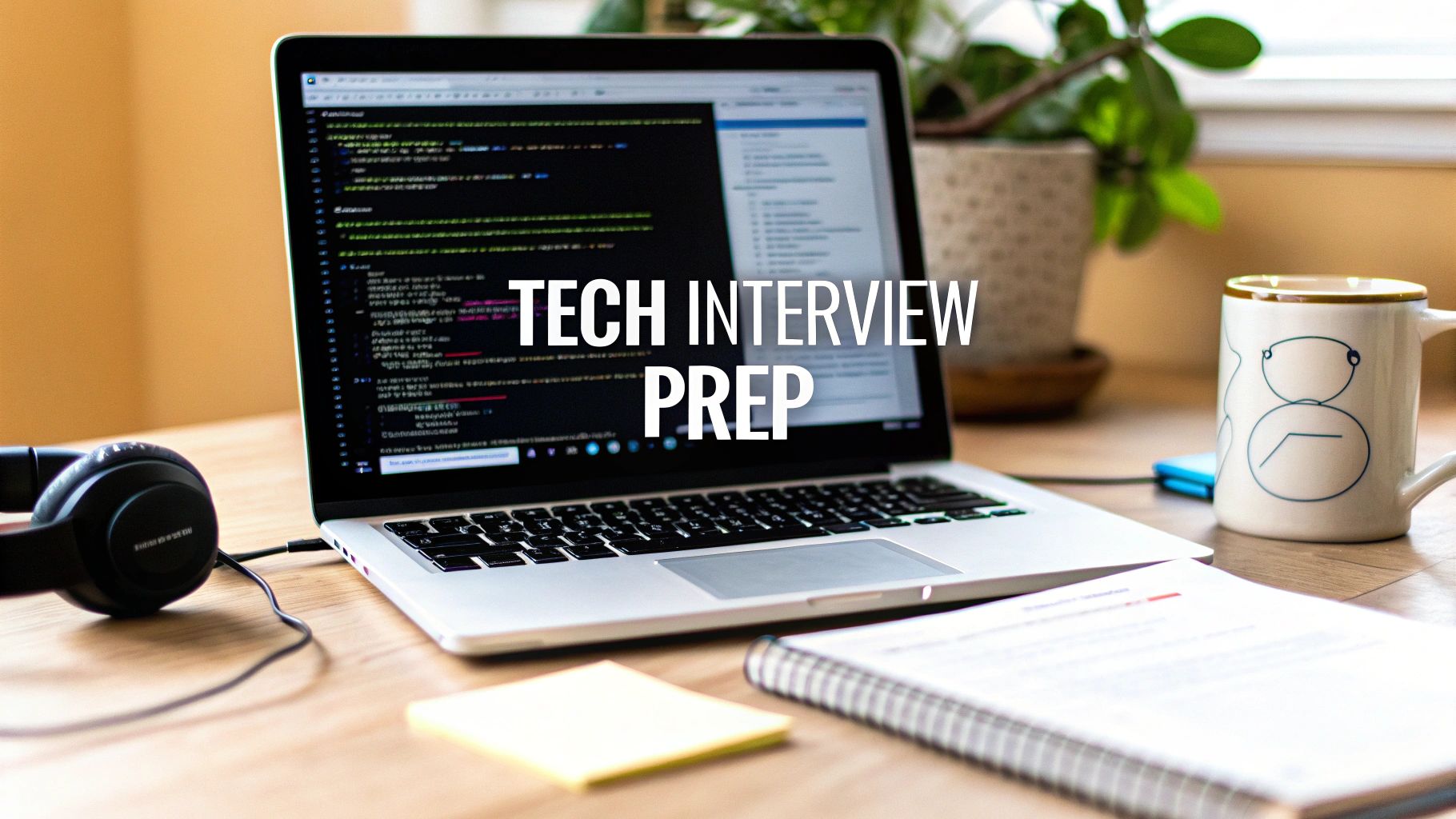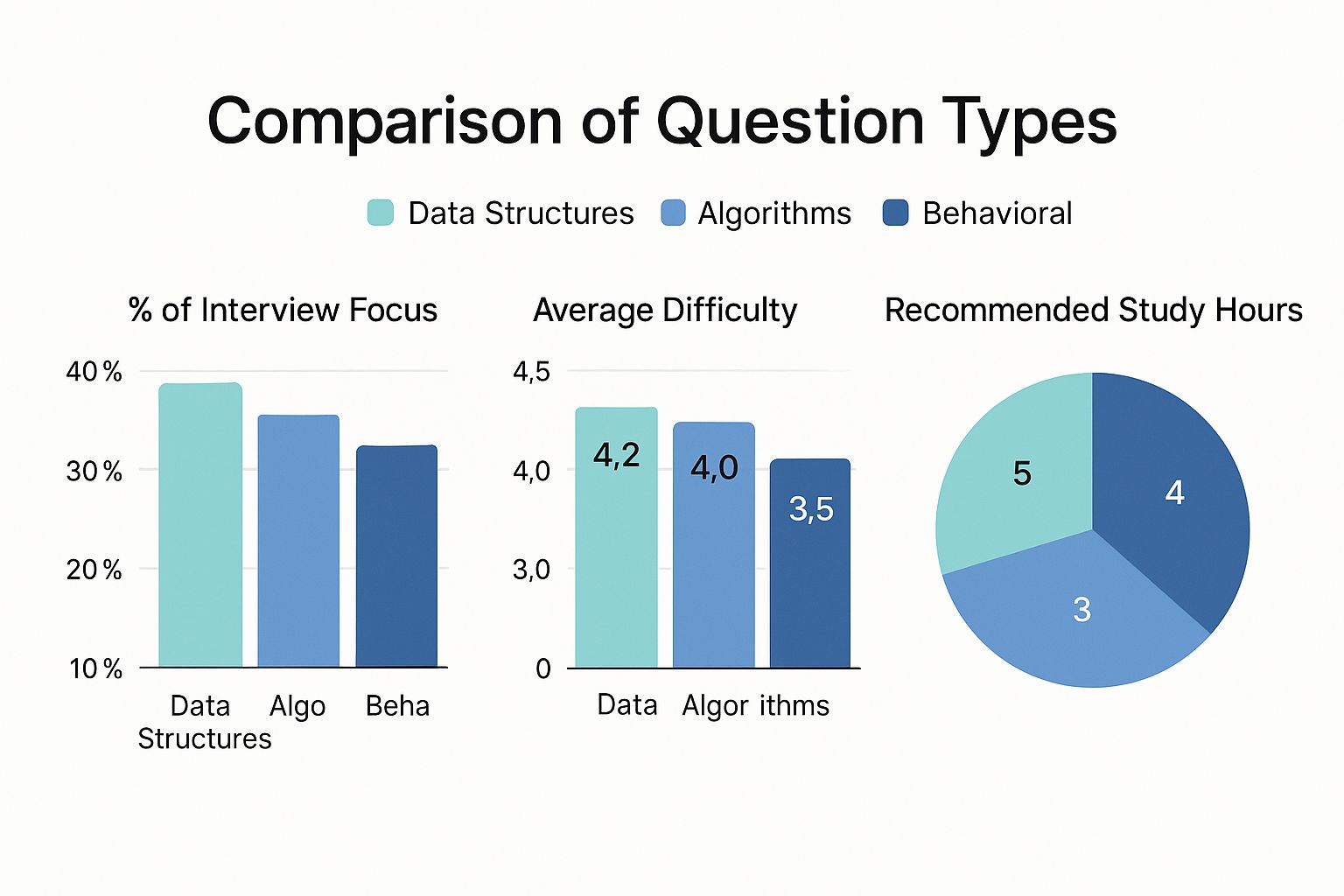Ace Your Technical Interview Prep Today

Before you even think about tackling a LeetCode problem, you need to get your head around what you're actually up against. Preparing for a technical interview today isn't just about practicing algorithms. It’s about building a smart strategy that acknowledges the fierce competition, the marathon-like timelines, and the AI gatekeepers you’ll have to get past.
This isn't just about being ready for the coding challenge; it's about being ready for the entire journey.
Understanding the Modern Tech Interview
Gone are the days of a simple whiteboard quiz. Today's technical interview is a multi-stage gauntlet in a hyper-competitive field. Just being a great coder, frankly, isn't enough anymore. To even get a foot in the door, you first have to understand the landscape you're stepping into—one defined by a flood of applications, lengthy hiring cycles, and new screening tech.
To get a real sense of the modern hiring funnel, it helps to look at the data. These numbers aren't meant to discourage you, but to arm you with the reality of the situation so you can prepare accordingly.
The Technical Interview Funnel at a Glance
| Stage/Factor | Key Statistic |
|---|---|
| Initial Application Success | Only about 2% of applicants actually land an interview. |
| Average Hiring Timeline | The entire process takes an average of five weeks from start to finish. |
| Interview Format | Virtual interviews are the norm, used by 90% of companies. |
| Virtual Interview Challenges | Technical glitches impact a surprising 62% of candidates. |
| AI in Screening | Already, 20% of companies are using AI to evaluate applicants. |
These statistics, drawn from various job interview trends, highlight just how much has changed. The path to an offer is longer and has more potential roadblocks than ever before.
Key Dynamics Shaping Your Prep
So, what does this all mean for you? It means you have to build a preparation strategy that's tough enough to withstand these pressures.
Here’s how these realities should directly shape your approach:
- Intense Competition: With a tiny fraction of applicants getting a call back, your resume and initial application can't just be good—they have to be flawless. They need to be optimized to get past both automated systems and the quick scan of a human recruiter.
- Extended Timelines: A five-week process is a long time to stay "on." It's an endurance test. Your study plan needs to be sustainable to keep you from burning out while ensuring your skills stay sharp from the first screen to the final round.
- Virtual First: Getting comfortable with the virtual format isn't optional. This is more than just having a decent webcam; it's about practicing how you communicate, how you present your thought process, and how you handle the inevitable awkwardness of a remote technical session.
The biggest mistake I see candidates make is focusing only on the coding. They forget that just getting to the coding stage is half the battle. Navigating the process itself is a skill, and it's one you need to practice.
Internalizing these facts is the real first step. It shifts your mindset from just "I need to solve problems" to "I need a strategy to navigate a complex system." This is what sets you up to handle the real-world hurdles you're about to face.
Building Your Technical Foundation

Let's be real: trying to prep for a technical interview by memorizing hundreds of solutions is a fool's errand. It's not about what you've seen before; it's about building a gut-level understanding of the fundamentals so you can tackle problems you've never seen before.
A truly solid foundation comes down to three key areas that all work together: Data Structures & Algorithms (DS&A), System Design, and, believe it or not, your Behavioral skills. Genuine mastery here is what separates a "maybe" from a "hell yes" offer. It’s the difference between just reciting an algorithm and being able to explain precisely why merge sort is a better fit than quicksort for a particular job.
Mastering Data Structures and Algorithms
Too many people treat DS&A prep like a frantic sprint, trying to cram as many LeetCode problems as possible before the big day. That's a direct path to burnout. The smarter, more sustainable approach is to learn to recognize the underlying patterns.
Think about it. A huge number of array-based questions can be cracked using patterns like the "sliding window" or "two pointers" techniques. When you focus on the pattern instead of the individual problem, you're not just learning one solution—you're learning a key that can unlock dozens of them. Suddenly, you're not memorizing 200 different answers; you're mastering 15-20 core patterns that you can adapt on the fly. Problem-solving becomes a creative exercise in logic, not a stressful memory test.
This is all about flexing your analytical muscles. If you want to go deeper, look for resources that help you develop problem-solving skills from the ground up.
A Structured Approach to System Design
System design questions are intentionally vague. "Design a ride-sharing service" or "Design a social media feed"—they're massive, open-ended prompts designed to see how you think, not whether you can produce a production-ready blueprint in 45 minutes. The interviewer wants to see how you navigate ambiguity and reason through complex trade-offs.
A structured framework is your best friend here. Don't just start drawing boxes. First, clarify everything. Ask probing questions to narrow the scope:
- What are the absolute must-have features for V1?
- What kind of scale are we talking about? 10 million daily active users? More?
- What are our targets for latency and availability?
Once you've defined the sandbox you're playing in, you can start sketching out a high-level design. Think about the big pieces: load balancers, web servers, databases, caches. Explain how they talk to each other. From there, the conversation will naturally dive into the interesting stuff—scalability issues, potential bottlenecks, and the trade-offs you're making with every choice.
The final diagram is just a prop. The real interview is the conversation you have while drawing it. Your ability to justify your decisions, talk through alternatives, and pinpoint potential weak spots is what will set you apart.
Don't Neglect Behavioral Skills
After all the technical grilling, the behavioral interview can feel like an afterthought. It’s not. It's often the final tie-breaker between two equally qualified engineers. This is where you prove you're someone people want to work with—that you can collaborate, handle disagreements, and take ownership of your work.
The STAR method (Situation, Task, Action, Result) is cliché for a reason: it works. The trick is to have your stories ready before you walk in. Aim to prepare 5-7 solid examples from your past projects. The real power move? Quantify your Result.
Don't just say, "I improved the API." Instead, try: "I redesigned a critical API endpoint, which reduced its average response time by 30% and cut our server costs for that service." That kind of concrete impact is impossible to ignore.
Designing an Effective Study Plan
If you’re just randomly grinding problems, you’re on the fast track to burnout. I’ve seen it happen countless times. The candidates who truly succeed are the ones who approach their prep with a structured, intentional plan. Think of it less like a frantic scramble and more like a deliberate training regimen, building strength and momentum over time.
The current tech hiring market is no joke—it’s fiercely competitive. While job postings have bounced back a bit, rising about 41% from a 2023 low to hit around 230,000 openings, we're still seeing less than half the demand from the 2020-2022 hiring frenzy. As The Pragmatic Engineer's analysis points out, this means companies are being incredibly selective. They want candidates who can prove they have deep, practical skills, which makes your preparation more critical than ever.

A Tangible 8-Week Schedule
A good study plan is all about balance. Instead of dedicating an entire week to one topic and risking burnout, you should mix things up. This approach keeps your mind fresh and helps you see how different concepts connect.
Here’s a practical, eight-week structure I’ve seen work wonders:
- Weeks 1-2: Get Your Fundamentals Down Cold. This is the time to go deep on core Data Structures and Algorithms. Don’t just read about hash tables, trees, and graphs—implement them from scratch. Use spaced repetition to make sure the concepts really stick.
- Weeks 3-5: Move into Focused Practice. Now you can start hitting platforms like LeetCode, but don't just pick problems at random. Zero in on one pattern at a time. Master "sliding window" problems until you feel totally comfortable, then move on to "two pointers."
- Weeks 6-7: Start Simulating the Real Thing. This is when you should be doing mock interviews, either with peers or on dedicated platforms. It's also the perfect time to start tackling system design. Walk through common scenarios and get used to clearly articulating the design trade-offs you're making.
- Week 8: Research and Refine. Ease up on the heavy problem-solving. Your focus now should be on the specific companies you’re interviewing with. Read their engineering blogs, get a solid understanding of their products, and prepare some genuinely thoughtful questions to ask them.
A study schedule isn't about being rigid—it's about creating consistency. It takes the guesswork out of your day-to-day prep and ensures you're building a complete, well-rounded skill set.
Ditch Passive Study for Active Learning
Let’s be honest. Watching videos and reading through solutions feels productive, but it’s mostly passive. The real skill-building happens through active learning: struggling with a problem, talking through your thought process, and getting concrete feedback.
This is where you can get a serious edge. When you’re doing a mock interview or even just talking a problem out loud to yourself, use a tool like ParakeetAI to record and transcribe the whole thing.
Later, you can review that transcript and get an objective look at how you communicate. You'll instantly see all your filler words ("um," "like," "you know"). You'll spot where your explanations got confusing or where you totally forgot to mention a key trade-off. This data-driven approach turns improving your communication from a vague goal into a measurable process.
To see more ways you can use smart tools to level up your prep, check out some of the other guides on our ParakeetAI blog. When you make your practice measurable, you stop hoping you're getting better and start knowing exactly where you need to improve.
Mastering Each Stage of the Interview Process

Think of the technical interview process less like a single sprint and more like a multi-stage marathon. Each leg of the race tests a different set of muscles, and you need a distinct game plan for every single one. You have to adapt your strategy as you progress, from that initial call with a recruiter to a deep-dive pair programming session with a senior engineer.
This whole multi-stage approach—screening calls, coding challenges, culture-fit chats—is how companies get a 360-degree view of who you are. They’re not just looking for raw coding talent. They want to see how you think, how you communicate your ideas, and whether you’ll genuinely click with the team.
The Initial Recruiter Screen
Don’t underestimate this first call. It’s your chance to make a strong first impression. The recruiter is your internal advocate, so your job is to give them every reason to champion you for the role.
This conversation is rarely about deep technical details. It’s a gut check on your motivation, communication style, and a high-level look at your experience.
You should be ready to clearly explain:
- Why this company? Go deeper than just "I like your product." Talk about a post on their engineering blog, an open-source project they maintain, or a core company value that you admire.
- Why this role? Draw direct lines from your past projects to the specific requirements in the job description. This proves you've done your homework.
- Your career goals. They're looking for drive and a sense of direction. Show them you have a plan.
Navigating the Technical Gauntlet
Once you've passed the recruiter screen, you enter the technical rounds. These can come in a few different flavors, and each one is designed to test something specific.
A technical phone screen is often the first hurdle. This is usually a classic test of your fundamental data structures and algorithms knowledge. You’ll be on a call, coding live in a shared editor, and you absolutely must talk through your thought process as you work.
Next up might be a pair programming session. Here, the dynamic shifts from pure problem-solving to collaboration. The interviewer wants to see how you work with another developer. Can you take feedback? Can you contribute ideas clearly? It’s less about getting the perfect answer and more about how you get there together.
The biggest mistake I see candidates make in technical rounds is going silent when they're thinking. Your thought process is just as important as the final code. Articulate everything—what you're trying, why it's not working, what you'll try next. It shows the interviewer how you solve problems.
Take-home assignments are also pretty common. These test your ability to build something more complete on your own time. The key here is to deliver code that's clean, well-documented, and thoroughly tested—just like you would for a real project at work. Don't treat it like a piece of homework; treat it like a professional code sample.
Ultimately, mastering the technical parts is just one piece of the puzzle. To really stand out, you also need to develop the essential interview skills that will get you hired.
Using Mock Interviews for a Competitive Edge
Knowing your data structures cold is one thing. Actually performing under pressure when the clock is ticking? That’s what lands the offer. This is where mock interviews become the single most powerful tool in your entire prep arsenal. They are the bridge between knowing something in theory and being able to execute in a real-world scenario.
Solving problems on your own just doesn’t cut it. It fails to replicate the stress of having someone watch your every move. You have to get comfortable thinking on your feet, talking through your logic, and handling curveball questions—all at the same time.
Finding Quality Practice Partners
The feedback you get is only as good as the person giving it. You need a partner who will challenge you and give you the honest, constructive criticism you need to hear, not just what you want to hear.
So, where do you find these people?
- Peers on the Same Journey: Other engineers who are also interviewing are your best bet. They’re just as motivated as you are, and you can swap roles, giving each other valuable practice as both the interviewer and the interviewee.
- Senior Colleagues or Mentors: A seasoned engineer brings a different perspective. They know what hiring managers at top-tier companies are really looking for, which often goes far beyond just a correct technical answer.
- Dedicated Platforms: If you’re struggling to find someone in your network, services like Pramp or Interviewing.io can match you with anonymous peers or even engineers from FAANG companies for incredibly realistic practice sessions.
The real goal of a mock interview isn't just about getting the right answer. It's a full dress rehearsal. You're practicing everything from asking sharp clarifying questions at the start to confidently walking through your test cases at the end.
Supercharging Your Practice with AI
A good mock interview partner gives you great feedback, but it's almost always subjective. "You seemed a little unsure there," or "Try to be more confident." What does that actually mean? This is where technology can give you a massive leg up.
By simply recording and transcribing your mock interview sessions, you can shift from vague opinions to hard, data-driven insights. It's a total game-changer.
When you run that recording through a tool like ParakeetAI, it analyzes your communication and gives you objective metrics you can actually work on. The AI will instantly flag things like:
- Filler Word Usage: It catches every single "um," "uh," and "like" that creeps in when you're nervous, which can make you sound less polished.
- Pacing and Clarity: Did you start talking way too fast when you got stuck? The AI can pinpoint moments where your explanation got muddled or rushed.
- Key Concept Recall: The transcript is your source of truth. You can review it to see if you clearly explained the time-space complexity trade-offs or if you completely forgot to mention an important edge case.
This kind of immediate, detailed feedback loop helps you polish the soft skills that so often separate two candidates who have similar technical chops.
Traditional vs. AI-Enhanced Mock Interview Prep
The difference is stark. While any practice is good practice, layering in AI analysis helps you spot your blind spots and improve much faster. Here’s a quick breakdown of how the two approaches stack up.
| Aspect | Traditional Mock Interview | AI-Enhanced Mock Interview with ParakeetAI |
|---|---|---|
| Feedback Type | Subjective opinions from your partner. | Objective, data-driven analysis of your speech patterns and clarity. |
| Analysis | Relies on memory and manual note-taking. | Provides a full, searchable transcript for detailed review. |
| Improvement Focus | General advice like "be more confident." | Actionable insights, e.g., "reduce filler words by 20%." |
| Accessibility | Dependent on your partner's availability and skill. | On-demand analysis you can perform anytime on your own. |
Ultimately, using a tool like ParakeetAI alongside your human practice partners gives you the best of both worlds: the realistic pressure of a live interview combined with the precision of data-backed feedback.
Common Questions About Technical Interview Prep
Once you start getting serious about preparing for technical interviews, a few common questions always seem to surface. These are the nagging doubts and uncertainties that can easily sidetrack you. Getting solid answers is the key to building a preparation strategy that actually works and gives you confidence.
This breakdown shows you where most interviews tend to focus, the general difficulty of each area, and a rough guide for how to allocate your study time.

As you can see, Data Structures and Algorithms take the biggest slice of the pie, but don't sleep on the behavioral side of things. It still accounts for a solid 25% of the evaluation. Let's dig into some of those frequent questions.
How Many LeetCode Problems Should I Actually Solve?
Forget about finding a magic number. The real mantra here is quality over quantity.
I've seen candidates who have rushed through 500 problems but can't explain the fundamentals, and I've seen others who land offers after mastering just 150-200 problems. The difference? The second group wasn't just solving problems; they were internalizing the underlying patterns.
Focus on deeply understanding the go-to patterns for core topics like arrays, graphs, dynamic programming, and trees. The goal isn't just to spit out a correct answer. It's to be able to talk through your logic, discuss the trade-offs of different approaches, and clearly justify your final choice. That’s what interviewers are actually listening for.
What Are the Biggest Red Flags to Avoid?
Honestly, the biggest mistakes are usually the simplest to fix with a bit of practice.
The first classic blunder is jumping straight into coding. Before you type a single character, take a moment to ask clarifying questions. What are the constraints? What are the edge cases? What does the input look like?
Another huge red flag is sitting in silence. You have to talk through your thought process, even if you’re stumbling. Let the interviewer into your head. And please, don't forget to test your own code! Walk through your solution with a couple of test cases, especially the tricky edge cases. Finally, don't just give up if you hit a wall. Explain where you’re stuck and what you’re thinking about. That shows resilience.
The ability to communicate your thought process, especially when you're stuck, is often more impressive to an interviewer than instantly knowing the perfect solution. It shows you're a collaborative problem-solver.
How Can I Prep for System Design Without Experience?
You absolutely do not need to have architected a system for a FAANG company to nail this part of the interview. The key is to learn the building blocks and practice putting them together.
Start by studying common architectural patterns—things like load balancing, caching strategies, and database sharding. A goldmine for this is reading through engineering blogs from companies like Netflix or Uber. You get to see how real-world systems are built to handle massive scale.
Then, practice applying these concepts with a consistent framework:
- Clarify: Lock down all functional and non-functional requirements.
- Estimate: Think about scale. How many users? How much data? How many requests per second?
- Design: Sketch out the high-level components and how they'll talk to each other.
- Dive Deep: Discuss trade-offs, potential bottlenecks, and single points of failure.
Grab a friend and work through classic prompts like "Design a URL shortener" or "Design a news feed." This process builds the structured thinking you need, no real-world experience required.
What Is the Best Way to Answer Behavioral Questions?
The STAR method (Situation, Task, Action, Result) is your best friend here. It's a simple framework that prevents you from rambling and forces you to deliver a concise, impactful story.
Before you even get to the interview stage, prepare five to seven solid stories from your past. Think about projects you led, conflicts you navigated, and mistakes you learned from.
Write them out using the STAR format and practice telling them out loud. When a behavioral question comes up, you can map it to one of your prepared stories. The most important part? The 'Result.' Always quantify your impact if you can. Instead of saying "I improved performance," say "By implementing this caching layer, we reduced API latency by 20%."
Ready to turn objective feedback into your competitive advantage? Let ParakeetAI transcribe and analyze your mock interviews, giving you the data-driven insights you need to polish your communication and land the offer. Get started with ParakeetAI today.




